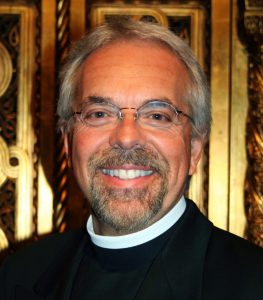
Fr Frank Marangos
Source: OINOS Educational Consulting
By Frank Marangos, D.Min., Ed.D., FCEP
Money is like manure; it’s not worth a thing unless it’s spread around encouraging young things to grow.” – Thornton Wilder
The Matchmaker is a four-act comedy written by playwright Thornton Wilder in 1955. Due to its success on Broadway, the high-society satire was adapted in 1964 as the highly acclaimed musical, Hello, Dolly! The Matchmaker’s fundamental comic storyline centers on a wealthy widower, Horace Vandergelder, who enlists the services of marriage-broker, Dolly Gallagher Levi, to find a new wife. Amusing pandemonium ensues when Dolly, herself a widow, decides she wants the tight-fisted millionaire for herself.
Like many theatrical parodies, The Matchmaker takes advantage of the socialite enigmas of love, arranged marriages, and money, in order to put its characters into waggish situations. The penny-pinching store owner, Vandergelder for example, dupes himself into accepting an idealized portrait of a much younger wife who is wealthy and infatuated with him. Ironically, while he refuses to let his niece marry an artist of modest means, Vandergelder becomes infatuated with his bohemian matchmaker. Even though she is not the sophisticated transactional mate that he was initially searching to find, he realizes that what he really wants and needs is Dolly, who informs the audience in the play’s final act that she plans to help Vandergelder make the world a better place by “spreading his money around like manure.”
The future of philanthropy in America promises to replace the transactional fundraiser with the transformational matchmaker. While pessimists are overly concerned about the impact of new federal tax laws which, they insist, no longer provide tax incentives, optimistic fundraising matchmakers see more reason for hope, believing that we have entered a “golden age of giving” where donors are motivated by personal values and direct engagement to make the world a better place by “spreading” their resources around like manure.
In their book, High Impact Philanthropy: How Donors, Boards, and Nonprofit Organizations Can Transform Communities (2001), Grace and Wendroff outline four major principles of high-impact altruism: (1) Issues, (2) Involvement, (3) Investment, and (4) Impact. According to the authors, transformational philanthropy “is a new phenomenon . . . a heightened understanding by donors of the importance of philanthropy in building communities, and institutions . . . and one of the most important milestones in the entire history of philanthropic growth in this country.”
Part 2 of this commentary will examine Grace and Wendroff’s final two principles of transformational philanthropy, namely, Investment and Impact. The essay will conclude with a brief analysis of the Giving Pledge (https://givingpledge.org/), a global foundation created by Bill and Melinda Gates and Warren Buffett, for transformational philanthropists around the world who collectively are setting a new standard of generosity among the ultra-wealthy.
Investment
A transformational investment may be understood as a donor’s desire to “spread” their sizable resources in a way that directly advances a philanthropic mission and, thereby, achieves large-scale change. It is the third vital principle of transformational philanthropy whereby investments are used to directly advance the aspiration, project, and/or mission-based value that a nonprofit claims to support.
In contrast, while transactional donors typically provide low-level and, often, one-time or sporadic financial support that is not necessarily directly connected to a nonprofit’s mission, transformational donors may be differentiated as strategic-minded investors who are looking for an impactful return on their initial investment. Although the term is more indicative of an entrepreneurial mindset rather than the amount of money involved, the transformational investor typically makes larger financial commitments that span several years and often include testamentary legacy bequests.
The more inspirational and credible a nonprofit’s case for support appears to donors, the larger the potential investment. If clarity and honest alignment concerning spending details cannot be simply conveyed, nonprofits will have a difficult time maintaining donor loyalty. As such, nothing sours the transformational donor’s nonprofit relationship faster than when they discover that their investments were not used for the purpose to which they were directed. In the final analysis, this is the value of regular communication and authentic transparency, both of which differentiate the transactional from the transformational philanthropic organization.
Impact
Transformational donors are interested in results, not needs. This fourth and final principle of Grace and Wendroff’s (2001) major principles of high-impact altruism cannot be overemphasized. High-impact philanthropy is sustained when donors, treated as partners, observe how their philanthropic investment provides meaningfull impact on a charitable organization. Those with the capacity to make such transformational investments want to be assured that their donations are sustainable, scalable, and highly impactful.
Pierre Omidyar, the founder of eBay, is a vocal exponent of such “impact investing.” A relatively new form of philanthropy, high-impact altruism can include microfinance, financial resources for people in the developing world who might otherwise not qualify for loans from commercial banks. Like private equity and/or venture capitalists that often generate 10-100 times return on an initial investment by identifying a key differentiator, savvy impact philanthropists seek to achieve exponential results by identifying and applying solutions to the root-cause of unmet societal privations.
Unlike their transactional counterparts, transformational donors are often impatient with bureaucracies. Like Omidyar, Bill Gates, Warren Buffet, and others, they are increasingly impact-oriented, favoring hands-on and long-term involvement, a phenomenon often referred to as venture philanthropy. Indeed, they are not simply donors but high-impact investors that must be understood and respected if nonprofits honestly seek to attract them. In the end, this is what drives this new transformational philanthropic paradigm.
Transactional giving is often in reaction to an event, an unexpected entreaty, or a well-timed request. Fundraising research studies can be cited that suggest that providing donors with a photo of a pre-adolescent orphan, ailing, or hungry child with general information can raise money. The data, however, describes relatively small contributions. Rational appeals, by contrast, focusing on ROSI (return on social investment), work better for higher-level transformational donors who are more apt to support nonprofit organizations that focus on strategic, sustainable, and high-level philanthropic outcomes. While there are certainly appropriate times and places for such petitions over a longer continuum, transformational giving requires more strategic consideration that creates synergy and leverages the efforts, energy, and resources of donor and organization around a common vision.
In the end, today’s donors want to engage in issues that matter deeply to them and to their communities. They want to effect perceptible change and in a manner that will achieve faster results. Whatever strategies are, therefore, implemented, contemporary fundraisers should strive to facilitate the principles and steps that effectively make the case for transformational impact investing both within the organization and outside it. Only by advancing a strategic fundraising methodology that is grounded on mission-based issues, donor involvement, and generous investment, can nonprofit, education, and faith-based organizations hope to achieve trailblazing levels of philanthropic results.
Roberta Brooke Astor was an American business woman who exemplifies the quintessential transformational philanthropist. Brooke became the chairwoman of the $60 million Vincent Astor Foundation, which had been established by her third husband, Vincent Astor, the great-great grandson of America’s first multi-millionaire, John Jacob Astor, “for the alleviation of human suffering.” Roberta earned international headlines when she died in 2007 at the age of 105 having donated nearly $200 million over a 38-year period. As a result of her generosity, Astor was awarded the Presidential Medal of Freedom in 1998. Remarkably, the self-declared motto that inspired her life’s prodigious liberality was none other than The Matchmaker’s aphorism concerning money and manure!
Three years after Roberta Astor’s death, forty of America’s wealthiest individuals joined together in a commitment to spread more than one half of their respective financial manure around the globe. Created by Bill and Melinda Gates and Warren Buffett, the Giving Pledge(https://givingpledge.org/) was established in 2010 following a series of conversations with philanthropists around the world about how they could collectively set a new standard of generosity among the ultra-wealthy. Like Brooke Astor, these transformational philanthropists envisioned the Giving Pledge as a multi-generational global effort to help shift the social norms of philanthropy toward giving more, giving sooner, and giving smarter.
Those who join the Giving Pledge are invited to write and post a personal letter explaining their decision to engage and describe the philanthropic causes to which they are devoted. Donors are united by a shared commitment to transformational giving and a desire to learn from experts about how best to leverage their philanthropy to address some of the world’s biggest challenges. As of 2018, the Giving Pledge includes 183 of the world’s wealthiest individuals, couples, and families from 22 different countries totaling over $365 billion.
Lipman Hearne, a Chicago-based marketing and communications firm that focuses on the nonprofit sector, has analyzed the letters of the Giving Pledge’s ultra-wealthy global donors and has identified five “mega-donor” archetypes: (1) Closer, (2) Strategist, (3) Enthusiast, (4) Explorer, and (5) World-builder. The archetypes are a valuable heuristic for philanthropic matchmakers interested in shaping mission-based case narratives that resonate powerfully with potential financial supporters.
The Closer describes a transformational donor who has an adventurous spirit and is comfortable taking calculated risks. The Strategist, on the other hand, is eager to have their donation used to develop systemic, self-sustaining solutions. While the Explorer is a true altruist who believes in the inherent value of “doing for others,” and is, therefore, a passionate evangelist for philanthropy, the Explorer, on the other hand, is self-consciously new to philanthropy, and is motivated to learn, experiment, and make a difference while avoiding missteps. The World-Builder is, finally, adept at pursuing a vision using every tool available to actively propel rapid and society-wide transformation, sometimes on global scale.
The transformational matchmaker should consider Lipman Hearne’s five archetypes when cultivating potential donors. The strategy, however, is not to niche a prospect, but to think expansively about the questions that may be posed to donors to help identify that values and experiences that shape and motivate their philanthropic aspirations. Who has inspired their life, and whom do they hope to influence? How do they describe their upbringing? When they talk about the source of their wealth, do they attribute it to fate, hard work, smart choices, or some combination? What do they consider the appropriate data that proves that their investment has been successful? These and other questions should guide and help the transformational fundraiser match donors to appropriate mission-driven philanthropic aspirations.
Philanthropy means “love of humankind.” Like meaningful marriages that are transformational and not transactional, successful philanthropic matchmaking is the result of authentic partnerships wherein donors and nonprofits work together to create change. Effective non-profit organizations identify and speak to a donor’s desires, values and motivations as opposed to simply communicating about their organization, and the organization’s needs. Like lasting marriages, they transfigure the couple beyond their personal needs. They elevate the relationship and, thereby, truly transform society.
During his 2015 presentation at the National Museum of American History, Bill Gates eloquently spoke about The Power and Impact of Giving and Philanthropy on American Life. Gates described transformational giving as a “catalytic approach to philanthropy” that “inspires the development of interventions that make the biggest difference, scaling solutions that work, measuring progress and adjusting strategies that encourage a new generation of philanthropists to think about the most effective ways to change the world by combining ingenuity with innovative ideas.”
The wealth of individual billionaires throughout the world is enormous. According to Forbes, the total net worth of the 400 richest people in the world is valued at $2.4 trillion. If every listed billionaire signed the Giving Pledge, approximately $1.2 trillion would be donated which would be as much the gross domestic product of Russia or Australia. Unfortunately, estimates calculate the amount of “lazy money,” stinking up offshore tax havens and overseas accounts, to be in excess of $1 trillion. One can only wonder what the consequence would be on humanity if such “manure” was freed up and spread across the global landscape to promote philanthropic innovation.


